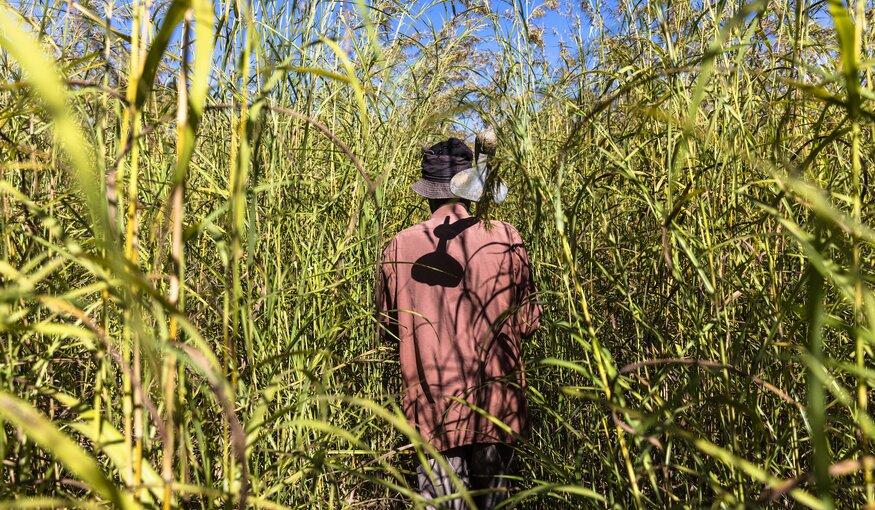Vision for 2030: Closing the Gap Between Ideal and Reality
 Small-scale farming of maize crops on the cusp of harvest time south of Serenje, Zambia.
Small-scale farming of maize crops on the cusp of harvest time south of Serenje, Zambia.2 March 2021
Stefan Schmitz | Executive Director
A collaborative global system for ex situ conservation of crop genetic resources is the vision that guides the Crop Trust’s work. As we decide where to direct our efforts in the coming years, it is timely to consider what this ideal system might look like.
Here is one interpretation: A system under which all unique ex situ accessions of crop diversity in the world are securely conserved in high-functioning genebanks. The accessions are properly safety duplicated, well documented, available internationally, compliant with phytosanitary standards and supported by sustainable, guaranteed, long-term funding.
This is, of course, an ideal. Like most ideals, there’s a chance it may never be fully realized—but it’s still worth striving for.
To date, the Crop Trust, with the help of its global partners, has achieved real impact. This energizes us and helps us remain committed to all that’s left to accomplish. Even if we cannot completely close the vast gap between that ideal and what we have achieved so far, we will reap enormous benefits from focusing on activities that will, at least, narrow it.
We must begin by closing smaller gaps, three types of which I consider here.
The first concerns the question of which genebanks we should partner with, and which crops should be funding priorities for ex situ conservation.
The main recipients of Crop Trust funding have been the international CGIAR collections, which come under Article 15 of the Plant Treaty. This support will continue, as will our support of the Svalbard Global Seed Vault.
But it is also worth considering whether and how our support could be extended to other genebanks. The collections of national and regional institutes, whose crop diversity is of such value and uniqueness, making a significant contribution to the global genepool, could also benefit from assistance.
Our project Seeds for Resilience, which is designed to support five national genebanks in sub-Saharan Africa, is an example of what this could look like.
And then there are the crops themselves.
The Crop Trust mission focuses on the 35 food crops listed in Annex I of the Plant Treaty. But while these food crops are important backbones of the world food supply, the spectrum of crops on which climate-resilient, productive, environmentally sound and healthy food systems are based is considerably wider.
Many neglected and underused crops have great potential to make the world’s diet more diverse and healthier. They also represent important sources of livelihood, especially for women smallholder farmers in the Global South.
Also worth considering are cash crops such as coffee or cocoa. They may not have direct key relevance for global food security, but millions of smallholder farmers depend on them, and their cultivation faces the same threats from climate change as food crops.
The second group of gaps that needs to be narrowed encompasses technical, capacity and information gaps.
On the technical side are conservation methods. The vast majority of crops have seeds that can be conserved relatively easily, through drying and freezing, known as “orthodox” seeds.
However, there are other important crops, like bananas, cocoa and coffee, that do not produce seeds, whose seeds are not orthodox and/or that are propagated vegetatively. As a result, these crops are usually conserved in field genebanks or in vitro. These methods are labor- and cost-intensive, require constant vigilance and—as the COVID-19 pandemic has shown—are open to considerable risks if collections cannot be regularly cared for.
A cutting edge method for conserving these crops’ genetic resources is cryopreservation. However, cryopreservation requires high up-front investment and is technically challenging.
Finding the resources to fund these conservation techniques and support the genebanks that use them is a critical, ongoing endeavor the Crop Trust is dedicated to.
And it leads to a matter that requires addressing: ensuring that the global system of ex situ conservation has sufficient numbers of adequately trained people to run it. A concern has been expressed in various quarters in recent years that training of the next generation of genebank staff is falling behind demand.
Furthermore, incomplete information limits the contributions that genebank staff can make right now. Genebanks exist not only to conserve diversity, but also to make it available and usable to farmers and breeders. For this, they require improved information management and sharing—something that Genesys, an online database of plant genetic resources for food and agriculture conserved in genebanks globally, is already contributing to.
As always, all of these efforts will depend on the available resources.
And now we come to the third kind of gap—the funding gap.
The Crop Trust has the advantage of its endowment fund, which has continued to generate steady returns even in the midst of the ongoing COVID-19 pandemic.
However, the endowment fund is still short of the amount needed to generate adequate annual income for stable, permanent financial support for the world’s most important genebanks.
To date, funding has come largely from traditional government donors, demonstrating a clear commitment from the public sector to safeguarding the world’s genetic diversity for future generations. But if we are to close the funding gap, we must be open to exploring new, innovative sources of finance.
The global system of ex situ conservation of crop diversity is not being built for its own sake. Rather, it serves as a life insurance policy for all humanity, for generations to come. Any small investments now will deliver manifold and recurring benefits.
Any small step that we and our partners take now is one more step toward narrowing the gaps and building a global system we can be proud of. One that serves humanity in the present and in the future for the betterment of all.
Category: GIZ Project
